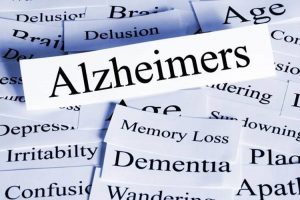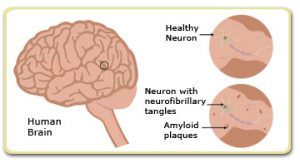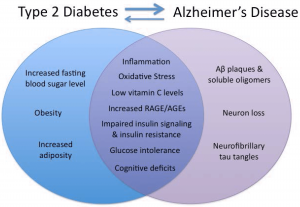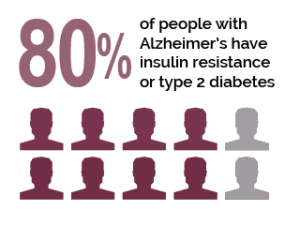
Alzheimer’s Disease (AD)
Alzheimer’s Disease (AD) is seen throughout popular culture today and is one of the most well known neurodegenerative disease there is. AD is the most common type of dementia, and is what most people often associate the disease with. Symptoms of AD include memory issues, confusion, problems speaking and writing, alterations in mood and personality. Despite how prevalent AD is and how much research is been put behind it, there is still very much that is not known about the progress of AD and why individuals with AD are being affected.
Neurofibrillary tangles
In understanding AD there are several aspects of disease that are essential to bigger picture. Neurofibrillary tangles (NFT) are one of these. In AD one of the major issue that occurs is proteins in the brain called Tau are hyperphosphorylated. This is one of the markers that is used to diagnose AD, as the malformed Tau proteins build up there is so malfunction associated with the cells. Exactly how this happens in not known but scientists are investigating how NFTs are directly associated with AD. It is believed that some or most of the communication between neurons are blocked because of these.
AB plagues
Amyloid is often used to describe proteins that are naturally produced by the body. The specific amyloid that is observed in AD is referred to as beta amyloid (BA) and is built up because the of incorrect cutting on amyloid precursor protein (APP). This incorrect cutting causes there to be longer BA in the brain which accumulates together to form plaques that cannot be broken down.

Figure 1: This image depicts the two most common identifiers of AD in the brain. There is also an observed loss of mass of brain mass, especially in the hippocampus which is an area associated heavily with memory.
Source: http://weeklyhealthtip.blogspot.com/2015/11/the-link-between-type-2-diabetes-and.html
What else do we know?
One of the major players scientists associated with AD are the cytokines of the immune system. Inflammation is seen in individuals who have AD and the response of the immune system to lower this inflammation is to send in cytokines. These are cells that have response on another cell, in this instance to give a response to inflammation. Thinking about the relationship between AD and cytokines is much like pondering the age old question of the chicken and the egg. Increased amounts of cytokines are associated with mutated APP molecules and Tau phosphorylation and eventually leads to neuron death which is a major culprit in neuroinflammation. So was it the inflammation and BA plaques that called the cytokines or excess cytokines that started the inflammation? A bigger question lays behind this, why is there a strong relationship between AD and type 2 diabetes? What about the two strings them together?
Type 2 Diabetes (T2D)
What is it?
Type 2 Diabetes (T2D) which is also known as adult onset diabetes, is when the body no longer processes glucose properly because of insulin resistance or the lack of the production of insulin. Insulin is the molecule in the body that is response for regulating the sugar molecule glucose in and out of the cells. Although T2D is more common in adults, as childhood obesity increases so does the chance of developing the disease. There is no cure for T2D but can be regulated through healthy eating and exercising.

Figure 2: The connection between the brain and body is undeniable but eating healthy not only helps with the regulation of T2D it also increases the overall sense of wellbeing and may help the brain in the long run, much longer than some people may think.
Source: https://www.medindia.net/patients/lifestyleandwellness/diet-and-alzheimers-disease.htm
Diet and Diabetes
As seen through ways to live with T2D, diet plays a large role. It is important for individuals with T2D to take insulin shots to increase the amount of insulin in the body but in addition to this, as stated above, taking careful notice of the food that you put into your body. As seen with younger individuals, those who experience or are on the verge of obesity are at risk of developing T2D, suggesting there is some relationship between T2D and food associated with obesity. Although the exact reason for T2D diabetes is unknown to researchers there is some evidence to suggest that weight gain and unhealthy eating are apart of the cause. What most people don’t associate with this however, is AD even though there is a clear link between the two.

Figure 3: A venn diagram shows the relationship between T2D and AD by comparing the similarities between the two. As seen above, there are more things in common than many people realize. The major classifiers of AD are seen listed as well but are not observed in T2D.
Source: https://www.mdpi.com/2072-6643/7/9/5341
Insulin in Alzheimer’s Brain: Type 3 Diabetes
Insulin is so well known in the development of T2D, as well as type 1, that many people do not often realize that it plays a major role in other parts of the body, including the brain. Insulin can increase spatial memory, is essential in cognitive and memory functions, as well as influencing feeding behavior. In patients with AD less insulin is seen as well. There is also a correlatory 80% of individuals who have AD also have insulin resistance of T2D, prompting AD to be called type 3 diabetes. Although there is much more research required behind this notion, scientists urge individuals (especially those with T2D or at risk of developing it) to eat better.
Another culprit in the development of both diseases is leptin. Leptin is a hormone that is made by the body to regulate caloric intake and feeding behaviors. In one study in particular, researchers found that there mice with high fat diets did not allow leptin to bind to neurons which never alerted the body that it was full and the mice continued to eat until they were overweight. Leptin also plays a role in the insulin pathway in the brain. Mutated leptin pathways often led to insulin resistance in individuals. This suggests that high fat diets that change the structure and purpose of leptin are not only associated with diseases related directly to insulin, such as T2D, but others like AD that have less information but what is known is the lack of insulin in the brain. This shows that there is no one common link between the three but rather may remain interconnected to each other.

Figure 4: Many individuals with T2D or at least insulin resistance are at risk of developing AD.
Source; https://ediblearia.com/2016/09/11/alzheimers-disease-is-type-3-diabetes/
Many people don’t realize that changing diet now may make a difference later in life. Not only in AD and the progression of the one not only the most debilitating diseases known to man but also the hardest to watch a loved one endure. It is so important for people to understand the connection between these diseases because in doing so it may aid for them to alter their lifestyle now so that they are able to experience the best possible future.
References:
https://www.alz.org/alzheimers-dementia/10_signs
https://www.brightfocus.org/alzheimers/infographic/amyloid-plaques-and-neurofibrillary-tangles